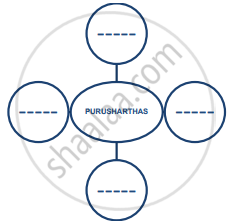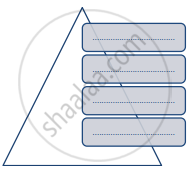Advertisements
Advertisements
प्रश्न
Write differences.
Status of Women in the Early Vedic Period and Later Vedic Period
उत्तर
| Status of Women in the Early Vedic Period | Status of Women in the Later Vedic Period |
| 1. Women had access to Vedic education during the early Vedic period. | During the later Vedic period, women were denied access to Vedic education. |
| 2. Women were entitled to the upanayana (thread) ceremony which enabled their entry into the Gurukul system of education. | Women were not allowed to attend school in the later Vedic period, and the upanayana ceremony was replaced by marriage, particularly child marriage. |
| 3. Educated women were divided into two categories: Sadyavadhu - those who pursued their education just until they were married and Brahmavadinis - those who never married and continued studying and imparting education throughout their lives. | The Later Vedic period witnessed a decline in the status of women in society. Women were now restricted to household duties and were barred from attending social assemblies. They were reduced to a subordinate status in the household. |
| 4. Women were considered useful and productive members of society. They could participate in social assemblies (vidath). They were also permitted to choose their life partners for marriage. |
The birth of a daughter began to be looked down upon and there is evidence to suggest the beginning of the practice of dowry. |
APPEARS IN
संबंधित प्रश्न
State two indicators of the declining status of women during the Later Vedic period.
Correct the incorrect pair and rewrite it.
Correct the underlined word and complete the statement.
Elementary education was imparted in Khanqahs during the medieval period.
Write short notes.
Status of women during the Medieval period.
Write differences.
Education in the Ancient Period and Colonial period in Indian society
Buddhism spread to several parts of India and beyond.
Give your personal response.
Jainism and Buddhism provided hope to all people.
The purusharthas is a part of ______ teaching.
Maktabs were centres of ______.
Correct the incorrect pair and rewrite it.
| I | Brahmin – Priest |
| II | Kshatriya – Trader |
| III | Vaishya – Farmer |
| IV | Shudra – Menial work |
Correct the underlined word and complete the statement.
Maktabs provide theological education.
Correct the underlined word and complete the statement.
Jnana Marg, Bhakti Marg, Raja Marg and Karma Marg are the four ways to achieve wealth.
Write differences.
Zoroastrianism and Islam
Explain the following concept with examples.
Ashramvyavastha
Explain the following concept with example.
Langar
Complete the concept map.

Complete the concept map.
Caste hierarchy

Complete the concept map.
Ashramvyavastha

State whether the following statement are true or false with reason.
Religious teachings have no influence on human behaviour.
Answer the following question in detail (in 150-200 words).
‘Religion has an impact on society.’ Discuss with suitable examples.
Correct the incorrect pair and rewrite it.
Correct the underlined words, complete and rewrite the statement:
Judaism is polytheistic religion.
Correct the incorrect pair and rewrite it.
Identify the appropriate term from the given options and rewrite it against the given statement.
Founder of Sikhism.
Correct the underlined word and complete the statement.
Higher education was imparted in Khangahs during the medieval period.
The new religion Din-I-Ilahi was established by ______.
Identify the appropriate term from the given options and rewrite it against the given statement:
It highlights exemplary religious, qualities which are emulated as role models by Jain women.
Correct the underlined word, and complete and rewrite the statement:
The atman is trapped in the bondage of birth and rebirth until it can attain Dharma.
Correct the underlined word, complete and rewrite the statement:
The ultimate aim of Hindus is Artha.
